|
CHAPTER XIV.
HOW THE STORY TURNS OUT.
The True Story of Christopher Columbus, Called the Great Admiral | ||
14.
CHAPTER XIV.
HOW THE STORY TURNS OUT.
WHENEVER you start to read a story that you hope will be interesting, you always wonder, do you not, how it is going to turn out? Your favorite fairy tale or wonder story that began with "once upon a time," ends, does it not, "so the prince married the beautiful princess, and they lived happy ever after?"
Now, how does this story that we have been reading together turn out? You don't think it ended happily, do you? It was, in some respects, more marvelous than any fairy tale or wonder story; but, dear me! you say, why couldn't Columbus have lived happily, after he had gone through so much, and done so much, and discovered America, and given us who came after him so splendid a land to live in?
Now, just here comes the real point of the story. Wise men tell us that millions upon millions of busy little insects die to make the beautiful coral islands of the Southern seas. Millions and millions of men and women have lived and labored, died and been forgotten by the world they helped to make the bright, and beautiful, and prosperous place to live in that it is to-day.
Columbus was one of these millions; but he was a leader
among them and has not been forgotten. As the world has
got farther away from the time in which he lived, the man
Columbus, who did so much and yet died almost unnoticed,
has grown more and more famous; his name is immortal, and
to-day he is the hero Columbus—one of the world's greatest men.
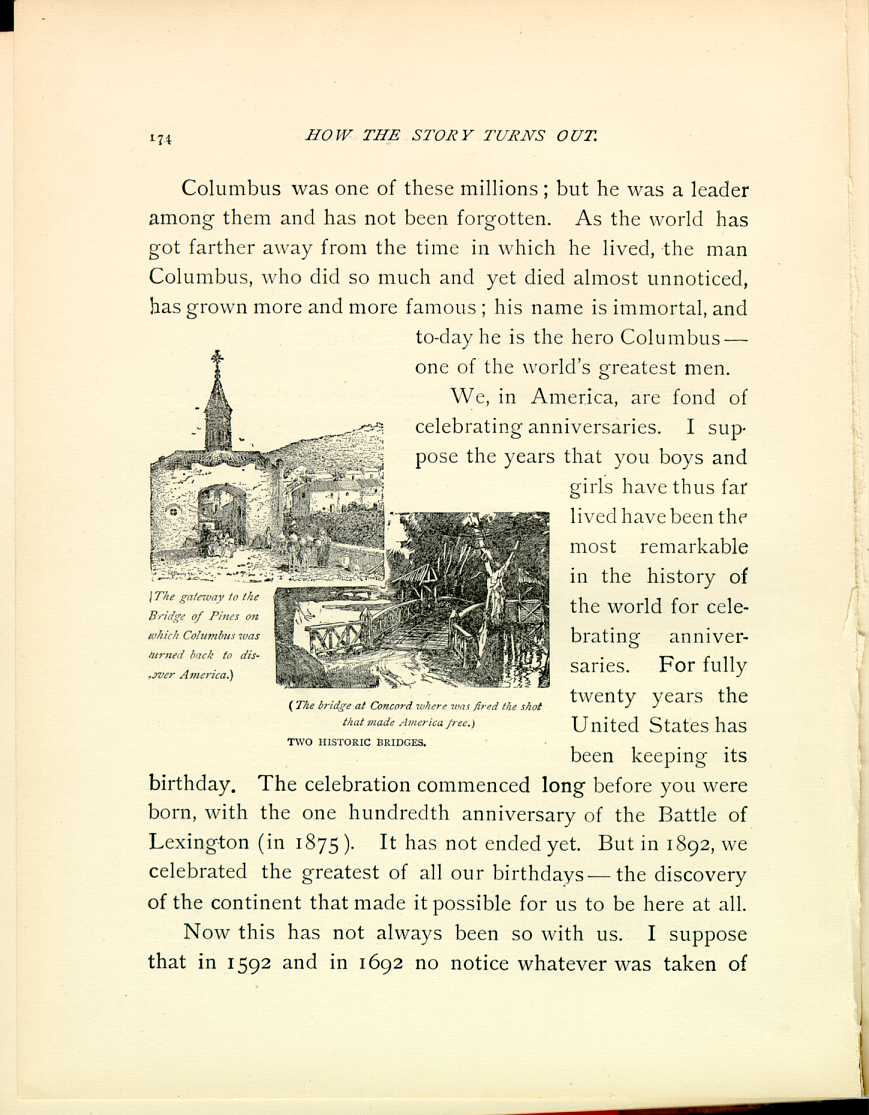
TWO HISTORIC BRIDGES
[Description:
Drawings of the Bridge of Pines and the bridge at Concord.
]
(The gateway to the Bridge of Pines on which Columbus was turned back
to discover American.)
and
(The bridge at Concord where was fired the shot that made America free.)
We, in America, are fond of celebrating anniversaries. I suppose the years that you boys and girls have thus far lived have been the most remarkable in the history of the world for celebrating anniversaries. For fully twenty years the United States has been keeping its birthday. The celebration commenced long before you were born, with the one hundredth anniversary of the Battle of Lexington (in 1875). It has not ended yet. But in 1892, We celebrated the greatest of all our birthdays—the discovery of the continent that made it possible for us to be here at all.
Now this has not always been so with us. I suppose that in 1592 and in 1692 no notice whatever was taken of
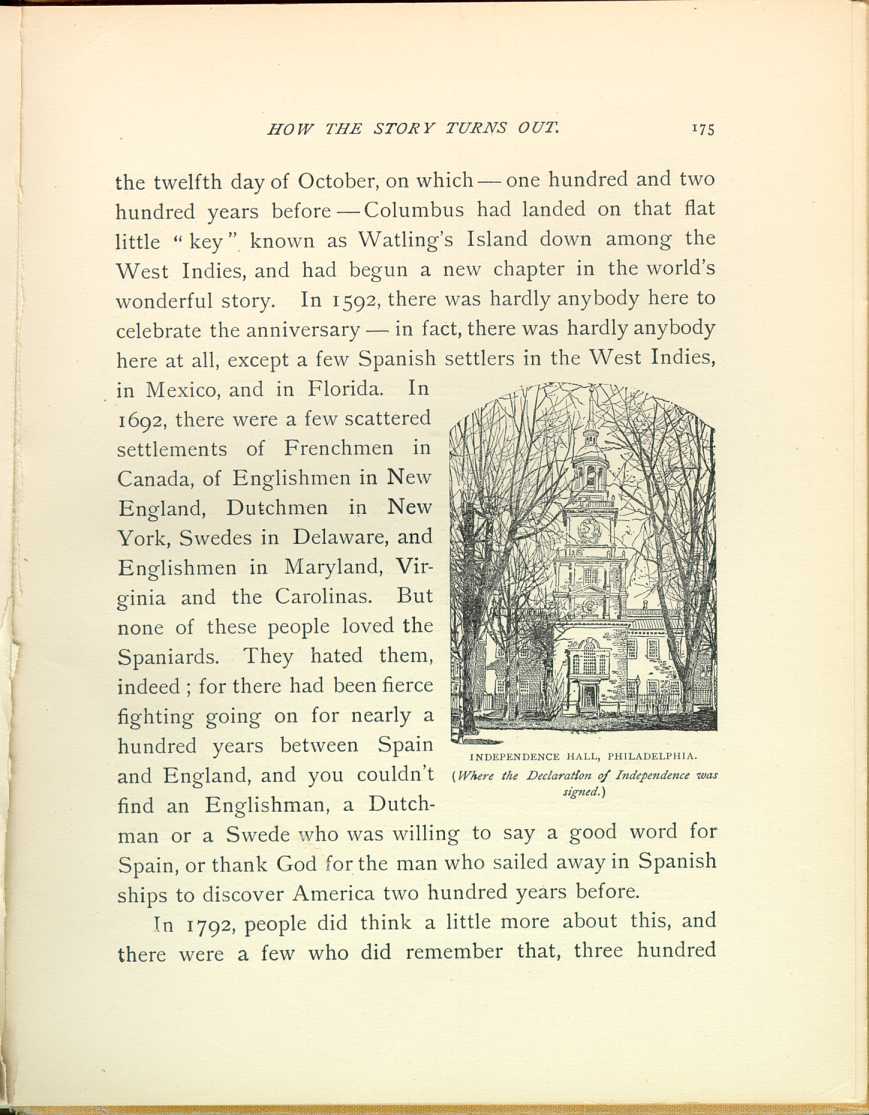
INDEPENDENCE HALL, PHILADELPHIA.
(Where the Declaration of Independence was signed.)
[Description:
Drawing of the front of Independence Hall.
]
In 1792, people did think a little more about this, and there were a few who did remember that, three hundred
We do not find, however, that in that year of 1792 there were many, if any, public celebrations of the Discovery of America, in America itself. A certain American clergyman, however, whose name was the Rev. Elhanan Winchester, celebrated the three hundredth anniversary of the Discovery of America by Columbus. And he celebrated it not in America, but in England, where he was then living. On the twelfth of October, 1792, Winchester delivered an address on "Columbus and his Discoveries," before a great assembly of interested listeners. In that address he said some very enthusiastic and some very remarkable things about the America that was to be:
"I see the United States rise in all their ripened glory before me," he said. "I look through and beyond every yet peopled region of the New World, and behold period still brightening upon period. Where one contiguous depth of gloomy wilderness now shuts out even the beams of day, I see new States and empires, new seats of wisdom and knowledge, new religious domes spreading around. In places now untrod by any but savage beasts, or men as savage as they, I hear the voices of happy labor, and see beautiful cities rising to view. I behold the whole continent highly cultivated and fertilized, full of cities, towns and villages, beautiful and
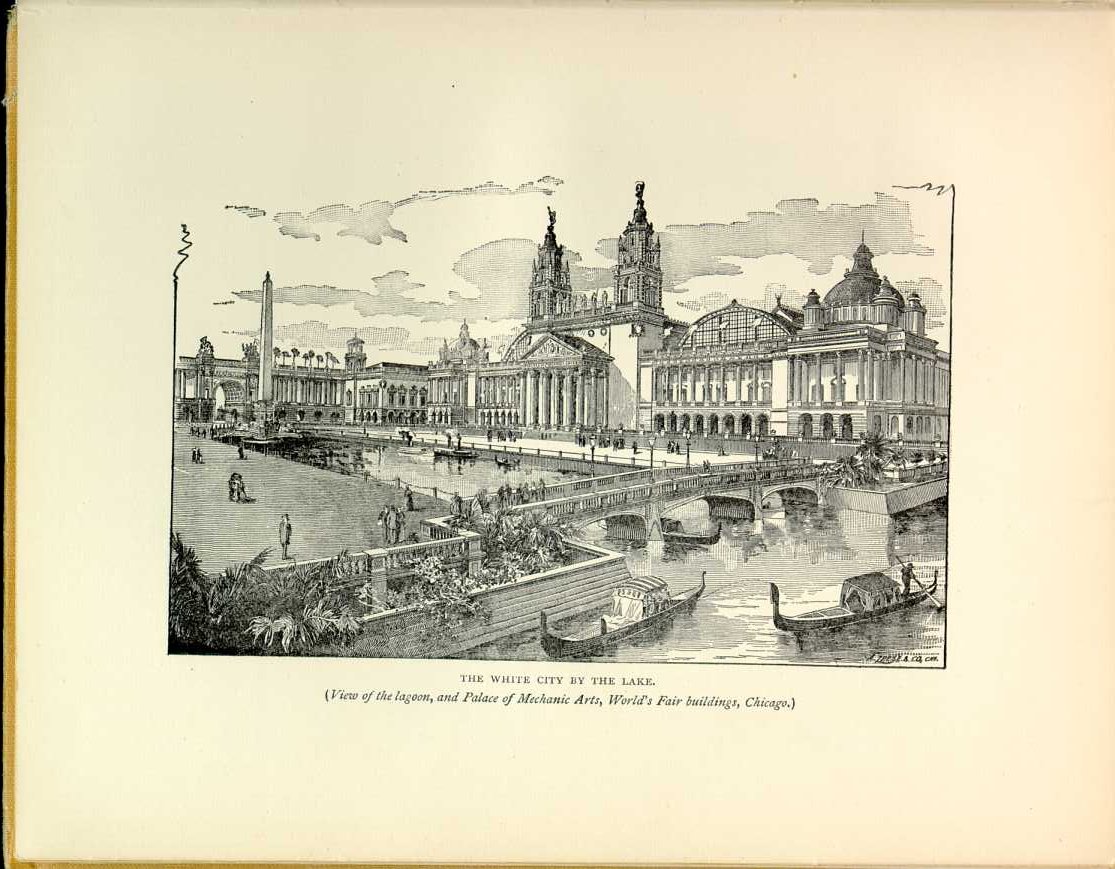
THE WHITE CITY BY THE LAKE.
(View of the lagoon, and Palace of Mechanic Arts, World's Fair
buildings, Chicago.)
[Description:
Drawing of the Chicago World's Fair buildings.
]

THE DISCOVERER OF OUR COUNTRY.
and
THE FATHER OF OUR COUNTRY.
and
THE SAVIOR OF OUR COUNTRY.
[Description:
Portraits of Columbus, George Washington, and Abraham Lincoln.
]
Of course, it was easy for a man to see and to hope and to say all this; but it is a little curious, is it not, that he should have seen things just as they have turned out?
In Mr. Winchester's day, the United States of America had not quite four millions of inhabitants. In his day
To-day, four hundred years after Columbus first saw

THE HARBOR OF NEW YORK CITY AND THE STATUE OF LIBERTY.
[Description:
Drawing of the Statue of Liberty and New York harbor.
]
Columbus was a dreamer; he saw such wonderful visions of what was to be, that people, as we know, tapped their foreheads and called him "the crazy Genoese." But not even the wildest fancies nor the most wonderful dreams of Columbus came anywhere near to what he would really have seen if—he could have visited the Exposition at Chicago, in the great White City by the lake—a "show city" specially built for the World's Fair of 1893, given in his honor and as a monument to his memory.
Why, he would say, the Cathay that I spent my life trying to find was but a hovel alongside this! What would he have seen? A city stretching a mile and a half in length, and more than half a mile in breadth; a space covering over five hundred acres of ground, and containing seventeen magnificent buildings, into any one of which could have been put

LOOKING DOWN THE LAGOON ON THE WORLD'S FAIR BUILDINGS.
[Description: Drawing of the Chicago World's Fair buildings surrounding the lagoon. ]
THE OLD AND THE NEW.
(In northern waters to-day the past and the present often meet, as
the Indians, paddling their canoes gaze in wonder upon the monster
steamship.)
[Description:
Drawing of two Native Americans in a canoe with a large ship in the
background.
]
But, whether you saw the Columbian Exhibition or not, you can say
that. And then stop and think what a parrot did. That is one of the
most singular things in all this wonder story you are reading. Do you
not remember how, when Columbus was slowly feeling his way westward,
Captain Alonso Pinzon saw some parrots flying southward, and believing
from this that the land they sought was off in that direction, he
induced Columbus to change his course from the west to the south? If
Columbus had not changed his course and followed the parrots, the
Santa Maria, with the Pinta and the Nina, would
have sailed on until they had entered the harbor of Savannah or
Charleston, or perhaps the broad waters of Chesapeake Bay. Then the
United States of to-day would have been discovered and settled by
Spaniards, and the whole history of the land would have been quite
different from what it has been. Spanish blood has peopled, but not
uplifted, the countries of South America and the Spanish Main. English
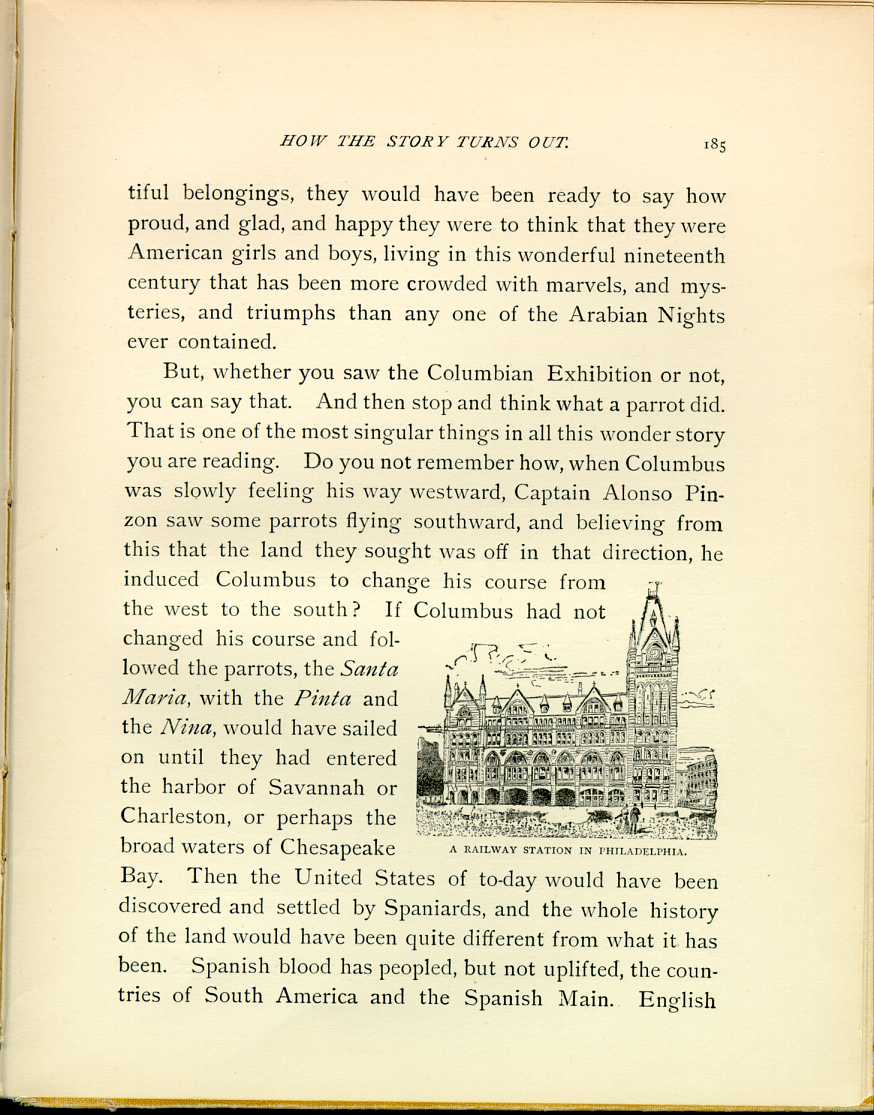
A RAILWAY STATION IN PHILADELPHIA.
[Description:
Drawing of a railway station in Philadelphia.
]
And this is what a flying parrot did: It turned the tide of lawless adventure, of gold-hunting, of slave-driving, and of selfish strife for gain to the south; it left the north yet unvisited until it was ready for the strong, and sturdy, and determined men
And thus has the story of Columbus really turned out. Happier
than any fairy tale, more marvelous than any wonder book, the story of
the United States of America is one that begins, "Once upon a time," and
has come to the point where it depends upon the boys and girls who read
it, to say whether or not they shall "live happily ever after."
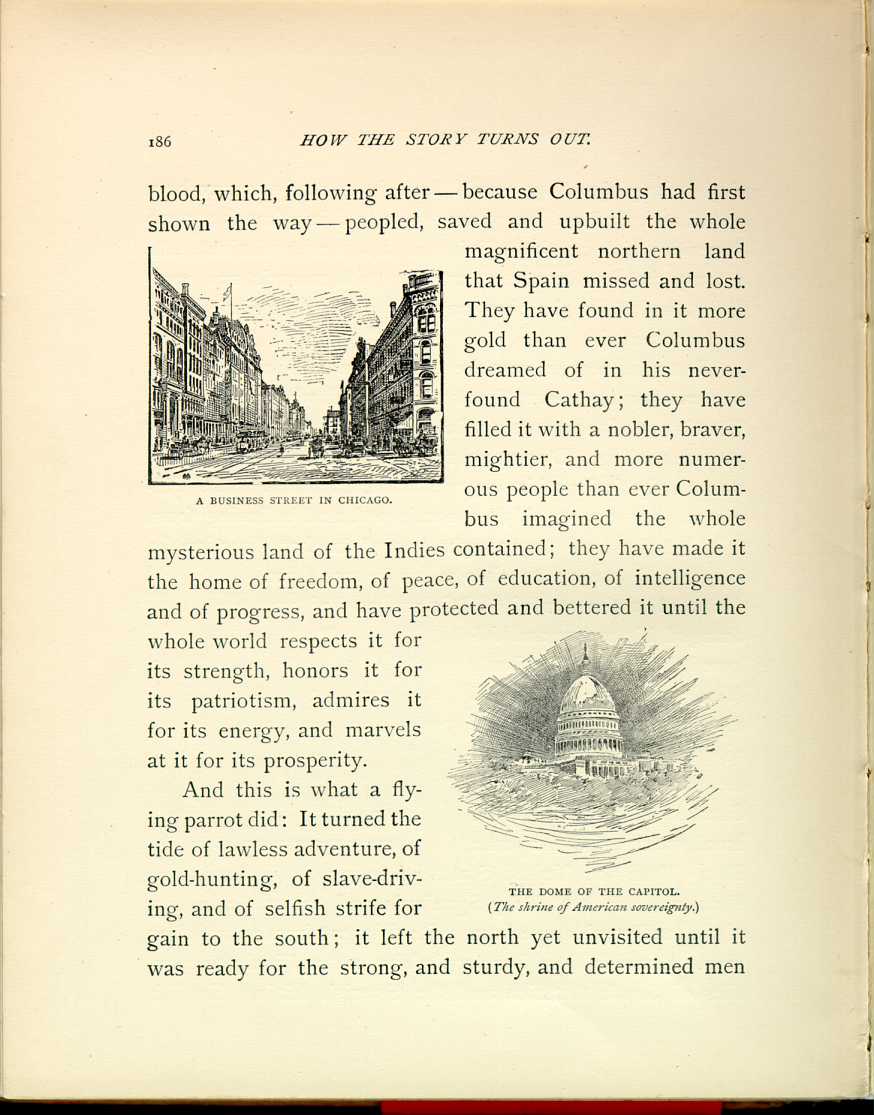
A BUSINESS STREET IN CHICAGO.
[Description:
Drawings of a Chicago street and the dome of the Capitol building.
]
and
THE DOME OF THE CAPITOL.
(The shrine of American sovereignty.)
The four hundred years of the New World's life closed its
chapter of happiness in the electric lights and brilliant
sunshine of the marvelous White City by Lake Michigan. It
is a continued story of daring, devotion and progress, that
the boys and girls of America should never tire of reading.
And this story was made possible and turned out so well,
because of the briefer, but no less interesting story of the
daring, the devotion and the faith of the determined Genoese
sailor of four hundred years ago, whom men knew as Don
Christopher Columbus, the Admiral of the Ocean Seas.
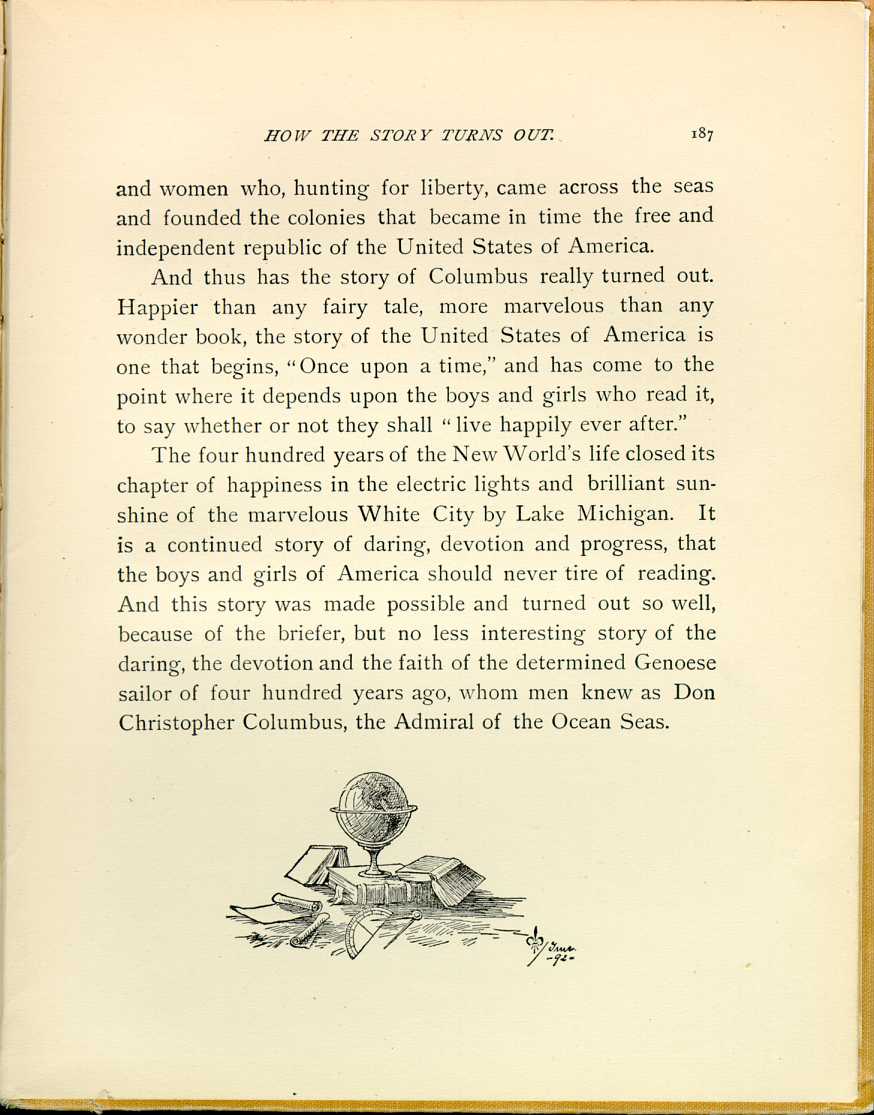 [Description:
Drawing of a globe, compass, and several books.
]
[Description:
Drawing of a globe, compass, and several books.
]
|
CHAPTER XIV.
HOW THE STORY TURNS OUT.
The True Story of Christopher Columbus, Called the Great Admiral | ||